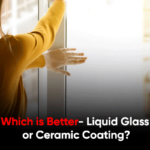Does Liquid Glass Actually Work?
When it comes to home and building protection, liquid glass coating is gaining attention for its advanced shielding capabilities. This innovative coating forms an invisible, ultra-thin layer that enhances durability, repels water, and prevents stains. Designed for use on walls, floors, countertops, and other surfaces, it offers a nano-protective barrier without altering the material’s appearance. But does it truly deliver on its promises? Let’s explore how liquid glass coating works, its benefits, and whether it’s the right choice for protecting glass coating for your home and commercial spaces.
What is Liquid Glass Coating?
HeatCure Transparent Liquid Glass Coating is a nano-coating technology specifically designed for homes and buildings. It creates an invisible, ultra-thin layer of silicon dioxide (SiO2) that protects surfaces from heat, UV rays, dust, water, and stains. Unlike traditional protective films or paints, this liquid-based solution bonds at a molecular level, ensuring a long-lasting shield without altering the appearance of glass, tiles, or walls.
This technology is widely used for windows, glass facades, tiled surfaces, and exterior walls, offering improved thermal insulation, self-cleaning properties, and weather resistance. But does it truly work as advertised? Let’s break it down.
How Does HeatCure Liquid Glass Work?
To understand how HeatCure heat-resistant liquid glass coating works, we need to look at its nano-technology foundation. The coating consists of nano-sized silica molecules, derived from quartz. When applied to a surface, these tiny particles create a molecular bond, forming an ultra-thin protective layer.
Here’s what happens step by step:
- Application – The liquid is sprayed or wiped onto the surface.
- Bonding – The nano-particles integrate with the surface at a microscopic level.
- Curing – Within a few minutes to a few hours, the coating hardens, forming a durable, transparent shield.
The result is a hydrophobic and self-cleaning layer, meaning it repels water, dust, and grime while also reducing heat absorption and UV damage. This makes it an ideal solution for energy-efficient homes and buildings.
Does HeatCure Liquid Glass Actually Work? (Myth vs. Reality)
There are bold claims about HeatCure Liquid Glass being heat-resistant, self-cleaning, and long-lasting. But how much of this is marketing hype, and how much is reality?
Marketing Claims vs. Real-World Performance
- Heat Reduction: The coating significantly reduces heat absorption by blocking UV and infrared rays, leading to cooler indoor temperatures. However, it does not eliminate heat entirely.
- Self-Cleaning Effect: The hydrophobic surface repels water and dust, reducing cleaning frequency, but it does not make surfaces completely maintenance-free.
- Scratch & Stain Resistance: While it prevents minor scratches and stains, it is not completely damage-proof.
- Durability: Properly applied coatings can last up to 10 years, depending on environmental exposure and surface type.
Pros and Cons of Using HeatCure Liquid Glass Coating
Like any protective product, HeatCure has its advantages and drawbacks. Understanding these can help you decide if it’s the right choice for your property.
HeatCure Liquid Glass Coating Pros
- Reduces Indoor Heat – Helps lower room temperatures by blocking infrared and UV rays.
- Self-Cleaning Effect – Water, dust, and grime slide off easily, reducing cleaning efforts.
- Preserves Aesthetic Appeal – Forms an invisible protective layer without affecting transparency.
- Weather and Stain Resistant – Shields surfaces from rain, pollution, and environmental damage.
- Long-Lasting Protection – When applied correctly, it can last for years without frequent reapplication.
HeatCure Liquid Glass Coating Cons
- Not a Replacement for Cooling Systems – While it reduces heat, it does not completely eliminate the need for air conditioning.
- Application Quality Matters – If not applied correctly, it may not deliver full protection.
- Initial Cost – The upfront investment can be high, but it pays off in the long run through energy savings.
- Provides resistance but does not prevent deep scratches.
Is HeatCure Liquid Glass Worth It? (Final Verdict)
So, should you invest Not Completely Scratch-Proof –n HeatCure Transparent Liquid Glass Coating for your home or building? The answer depends on your specific needs and expectations.
Who Should Consider HeatCure?
- Homeowners looking to reduce indoor heat without blocking natural light.
- Building owners wanting to lower maintenance costs with self-cleaning surfaces.
- Those living in high-pollution areas where dust and stains accumulate quickly.
Best Use Cases
- Glass windows and facades – Reduces heat absorption and prevents water spots.
- Tiled surfaces and walls – Keeps them stain-resistant and easier to clean.
- Balconies and skylights – Enhances durability against environmental exposure.
Alternatives to HeatCure
- Reflective Window Films – Blocks heat but may alter transparency.
- Ceramic Coatings – Provides heat resistance but requires professional application.
- Traditional Sealants and Paints – Cheaper but may lack durability and transparency.
Read more: Which is Better- Liquid Glass or Ceramic Coating?
Conclusion
HeatCure Transparent Liquid Glass Coating is an advanced solution for modern homes and buildings, offering heat reduction, self-cleaning properties, and weather resistance. While it does not completely eliminate heat or cleaning needs, it provides significant long-term benefits by making surfaces more durable and easier to maintain. If you’re looking for a cost-effective way to improve energy efficiency and surface protection, HeatCure is definitely worth considering.
For those seeking premium protection for home surfaces, HeatCure Liquid Glass Coating is an excellent choice. Specially designed for residential and commercial applications, it offers superior waterproofing, stain resistance, and durability. If you want a reliable, invisible shield for your interiors and exteriors, HeatCure is a smart investment.


Comment (0)